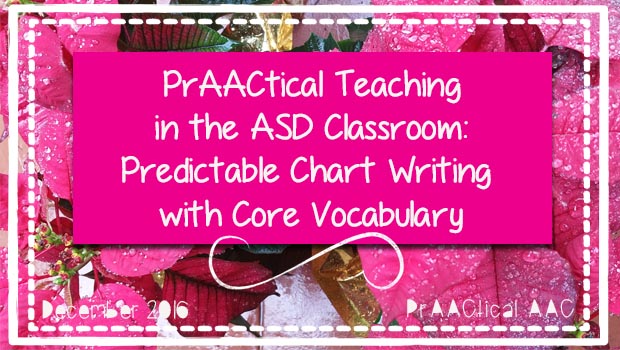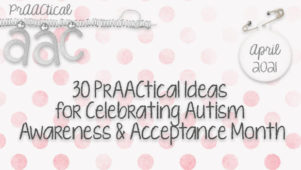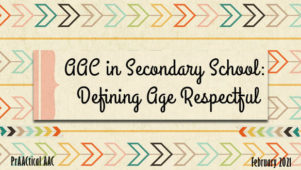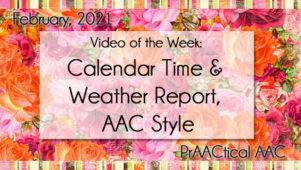PrAACtical Teaching in the ASD Classroom: Predictable Chart Writing with Core Vocabulary

We are closing out the year with a bang by combining two of our favorite things: working on AAC and literacy. In this post, Michigan-based teachers Amy Devin and Lauren Pawlowski return to discuss their strategies for building communication skills in the context of writing activities. Enjoy their detailed descriptions of how they implement a 5-day writing sequence in their classrooms!

::::::::::::::::::::::::::::::::::::::::::::::::::::::::::::::::
Predictable Chart Writing with Core Vocabulary
If writing with your students is something you are apprehensive about, then Predictable Chart writing is a good place to start. You get a lot of bang for your buck, as you can work on many different concepts as you are instructing through the week. Some areas you will be able to work on is location and meaning of core, concepts about print, print awareness and fine motor skills.
Prior to starting your Predictable Chart Writing, you have to have a plan on which words you will use in instruction. Each week should be unique in what words you are using. Yes, you will use some words more often than others ( I, you, go), but don’t get stuck in the rut of using the same starter sentences every time. The way we choose our words for that week is by planning out our word wall words for the entire year prior to the school year starting. Each week we introduce five new words, 2-3 of which are core. We share this with our speech pathologist and she too focuses on these words on the same week/month. These 2-3 words are the ones we will use in our predictable chart writing and will also focus on during shared reading and vocabulary instruction during the week. However you select your words is great, just be sure to carry it over in all of your instruction for the week or month.
Now that you have a plan of what words you want to use, you can roll out Predictable Chart writing all week with 5 different activities. Once you understand the framework of Predictable Chart writing, you will be able to carry this routine easily through the year.
Day 1: Writing the sentences
Most recently we did a chart writing on decorating a felt gingerbread man. We used the starter sentence “I will put on the ______.” Prior to having the students do this task, it is essential come up with responses that they might have. If you can’t come up with more than five, choose a different starter for them. You want this to be easy enough that students aren’t checking out before the writing begins. Have your list ready, and any props, pictures or fringe that you may need.
Day 2: Reread sentences and analyze
This day will be about exploring the writing sample. Be sure to have students read it several times with different focus points. Maybe one time through they are finding a core word you are focusing on. Maybe another time you are working on concept of word or even punctuation. Read through it 3-4 times, helping your students to gain competency and comfort with the sentence they wrote.
Day 3: Cutting and reconstructing sentences.
To prepare for this, you will need to write each sentence on a sentence strip with normal spacing. It should look like normal text and spacing, because we want to know if they have concept of word. Do a sample for the students and talk aloud how you look for the spaces and cut between each word. Before cutting the sentence apart, have your student read their text 1-2 times. Then students will cut apart their sentences into words. You are not telling them where to cut. If your student isn’t able to cut, run your finger along the bottom of the sentence strip and have them communicate to you when to cut or stop to cut. (words you could have your student signal to cut; stop, here, make, do) If students cut their sentence into 50 little pieces, let them and then when they go to reconstruct it, talk about how it is really hard to do because their are not words and just a whole bunch of letters. Let them make a mistake a learn from it! We once had to rewrite the sentence strip 6 times for a student, and by golly, the next week when we did the activity, she did it in 3 tries and then 1 from then on. We never told her she was wrong, we talked about it and she was able to learn from it.
Day 4: Be the Sentence
We like to call this organized chaos. Even after years of doing this with students, it still looks chaotic, even when they are being successful! This activity involves students re-creating a sentence chosen from the sentences chart writing you did. Write each word on a separate piece of paper and give each student one word. Read the sentence and have students rearrange themselves to recreate it. Again, if your students can’t move independently, have them communicate with a partner to get where they need to be ( go, stop, here, more go, put here, over, good, first). This can be a challenging activity as it needs a lot of scaffolding in the beginning. But they will get there!
Day 5: Make a book!
We use Tarheelreader.org to make our books. It has many photos on it that you can use to make your book. But you may also make them in other computer programs or from magazines or real photos. This is a very important step in Predictable Chart Writing, as it helps the students to have ownership in their writing and reading skills! Our students love this stage the best. Put completed books in your library. Our students gravitate to these ones and will read them multiple times.
Have fun and remember you are learning along the way, just like your students. This can quickly become one of your students’ most favorite time of day. There is a lot of ownership in what they are achieving and they are successful with all the practice! Enjoy!
For a more in depth explanation of Predictable Chart Writing and other core and literacy components, please visit www.project-core.com and explore the professional development modules. Even after many years of instructing in the blog topics that we talk about, we still refer to modules to refresh our knowledge.
Filed under: Featured Posts, PrAACtical Thinking
Tagged With: ASD, classroom, school, writing
This post was written by Carole Zangari





3 Comments
Love these structured steps. Do you have any pics to share of the finished product, if applicable, from any of the days?
Jennifer! I did PCW last year and have some photos of the books my class made.
I would love to see photos too! Great post, thank you!